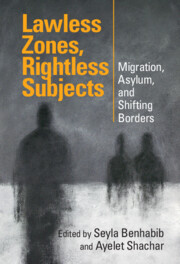Refine search
Actions for selected content:
45 results
Border Bureaucracy and Discourses: Demarcation and Surveillance of the Punjab Border in the Wake of 1947 Partition
-
- Journal:
- Critical Pakistan Studies ,
- Published online by Cambridge University Press:
- 15 October 2025, pp. 1-20
-
- Article
-
- You have access
- Open access
- HTML
- Export citation
8 - Borders
- from Part IV - (Dis)Connected Pasts
-
- Book:
- Fractured Pasts in Lake Kivu’s Borderlands
- Published online:
- 17 July 2025
- Print publication:
- 31 July 2025, pp 249-271
-
- Chapter
- Export citation
Chapter 10 - Borders and the Liminal
- from Part II - Developments
-
-
- Book:
- Space and Literary Studies
- Published online:
- 07 May 2025
- Print publication:
- 22 May 2025, pp 172-185
-
- Chapter
- Export citation
Of Jungles, Deserts, and Bandits: State-Sanctioned Danger in the Border Regimes of 1940s ‘Aden and 2020s America
- Part of
-
- Journal:
- Public Humanities / Volume 1 / 2025
- Published online by Cambridge University Press:
- 02 April 2025, e64
-
- Article
-
- You have access
- Open access
- HTML
- Export citation
6 - The Border as Accordion
- from Part II - New Geographies of Borders: Territory, Land, and Water
-
-
- Book:
- Lawless Zones, Rightless Subjects
- Published online:
- 02 January 2025
- Print publication:
- 09 January 2025, pp 109-123
-
- Chapter
-
- You have access
- Open access
- HTML
- Export citation
5 - The Border Within
- from Part I - Territoriality and Rights Protection
-
-
- Book:
- Lawless Zones, Rightless Subjects
- Published online:
- 02 January 2025
- Print publication:
- 09 January 2025, pp 90-106
-
- Chapter
-
- You have access
- Open access
- HTML
- Export citation

Lawless Zones, Rightless Subjects
- Migration, Asylum, and Shifting Borders
-
- Published online:
- 02 January 2025
- Print publication:
- 09 January 2025
-
- Book
-
- You have access
- Open access
- Export citation
4 - The Khetem-Border-Posts in the Delta during the New Kingdom
-
-
- Book:
- The Nile Delta
- Published online:
- 15 February 2024
- Print publication:
- 22 February 2024, pp 158-184
-
- Chapter
- Export citation
1 - Nationality and Ethnicity in the Ancient Near East
- from Part i - The Politics of Ethnicity, Nationhood, and Belonging in the Settings of Classical Civilizations
-
-
- Book:
- The Cambridge History of Nationhood and Nationalism
- Published online:
- 27 October 2023
- Print publication:
- 09 November 2023, pp 11-30
-
- Chapter
- Export citation
12 - Situating Latinx Immigrant Romantic Relationships in the Context of Illegality
-
-
- Book:
- The Sociocultural Context of Romantic Relationships
- Published online:
- 19 October 2023
- Print publication:
- 02 November 2023, pp 226-246
-
- Chapter
-
- You have access
- Open access
- HTML
- Export citation
Chapter 5 - Lynchpins of Sovereignty
- from Part I - Origins Revisited
-
-
- Book:
- Diaspora and Literary Studies
- Published online:
- 20 July 2023
- Print publication:
- 10 August 2023, pp 95-111
-
- Chapter
- Export citation
Looking into the border. Whiteness, (un)desirable encounters and research containment at the Spanish–Moroccan border
-
- Journal:
- Libyan Studies / Volume 54 / November 2023
- Published online by Cambridge University Press:
- 11 July 2023, pp. 45-54
- Print publication:
- November 2023
-
- Article
-
- You have access
- Open access
- HTML
- Export citation
Chapter 15 - Salman Rushdie and Diasporic Identities
- from Part III - Historical and Cultural Contexts
-
-
- Book:
- Salman Rushdie in Context
- Published online:
- 23 March 2023
- Print publication:
- 30 March 2023, pp 193-204
-
- Chapter
- Export citation
The Net Benefits and Residual Cost from U.S. Border Management of the Initially Inadmissible
-
- Journal:
- Journal of Benefit-Cost Analysis / Volume 14 / Issue 1 / Spring 2023
- Published online by Cambridge University Press:
- 28 February 2023, pp. 163-189
-
- Article
- Export citation
Chapter 14 - Contemporary Stories of Deportation and Migration
- from Part III - Mobilities
-
-
- Book:
- Latin American Literature in Transition 1980–2018
- Published online:
- 24 November 2022
- Print publication:
- 08 December 2022, pp 215-230
-
- Chapter
- Export citation
Chapter 18 - Transnationalism and Environment in Contemporary Irish Literature
-
-
- Book:
- A History of Irish Literature and the Environment
- Published online:
- 14 July 2022
- Print publication:
- 28 July 2022, pp 358-376
-
- Chapter
- Export citation
Chapter 8 - Queer Borders
-
- Book:
- Victorian Women Writers and the Other Germany
- Published online:
- 02 June 2022
- Print publication:
- 09 June 2022, pp 187-208
-
- Chapter
- Export citation
Designs of borders: Security, critique, and the machines – CORRIGENDUM
-
- Journal:
- European Journal of International Security / Volume 7 / Issue 3 / August 2022
- Published online by Cambridge University Press:
- 09 February 2022, p. 411
-
- Article
-
- You have access
- HTML
- Export citation
6 - Chin Peng and Communist Plans
-
- Book:
- The Malayan Emergency
- Published online:
- 16 December 2021
- Print publication:
- 16 December 2021, pp 247-286
-
- Chapter
- Export citation
8 - Hemispheric Routes
- from Part II - Approaches
-
-
- Book:
- The Cambridge Companion to Twenty-First Century American Fiction
- Published online:
- 02 September 2021
- Print publication:
- 23 September 2021, pp 157-173
-
- Chapter
- Export citation
